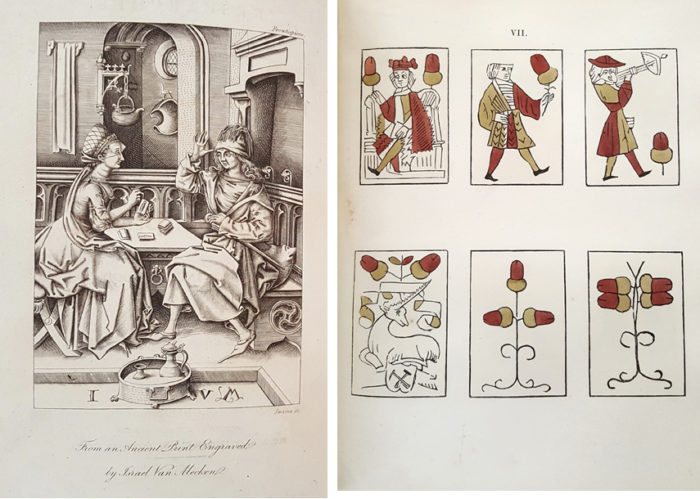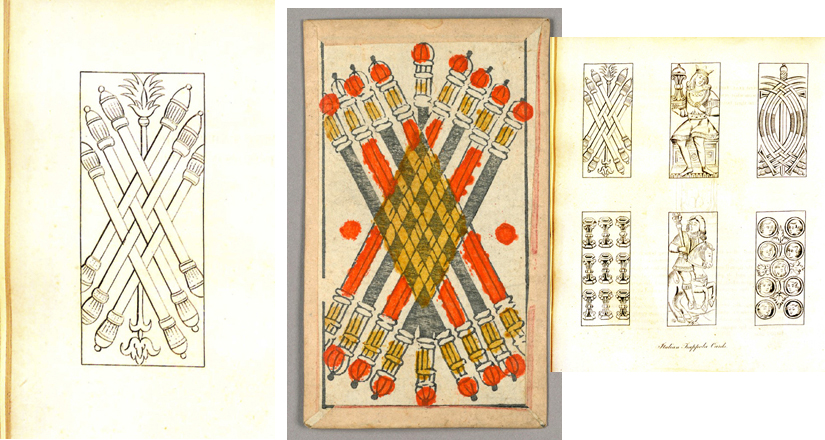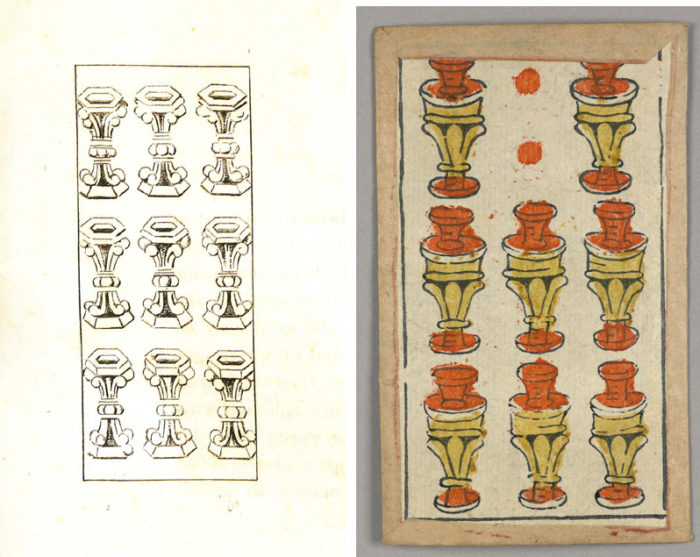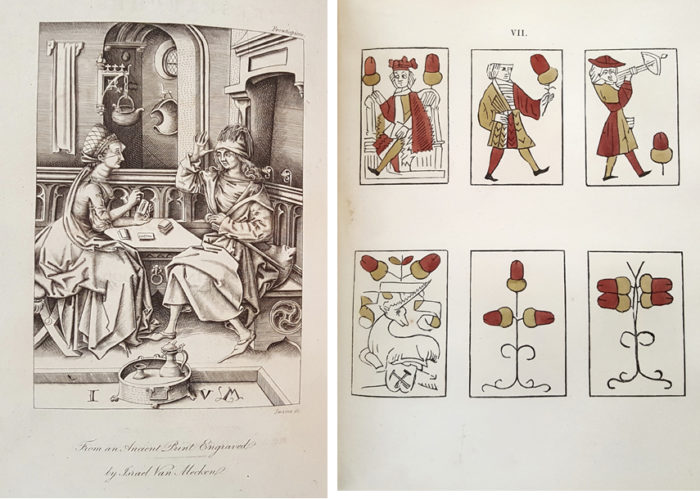
L: Book illustration (England), 1816; engraving. Title page: From an ancient print engraved by Israel Van Mecken. Researches into the history of playing cards; with illustrations of the origin of printing and engraving on wood … By Samuel Weller Singer. London, R. Triphook, 1816. GV1233 .S61X CHMRU. Smithsonian Libraries. R: Acorn suit of playing cards. Book illustration (England), 1816; engraving. German playing cards, Plate VII. (with suits of bells, hearts, leaves and acorns). 15th century. GV1233 .S61X CHMRU. Smithsonian Libraries.
The library owns books like Researches into the history of playing cards that supports research into the objects in the museum’s curatorial departments. In studying this book, I was able to make a connection between the illustrations and some playing cards in the Cooper Hewitt Museum’s Drawings & Prints collections. This book is an in-depth research into the history of playing cards, with black and white engravings, and eight hand-colored woodcuts. Smithsonian Libraries’ has an Adopt-a-Book Program that provides essential funding to support the conservation, acquisition, and digitization of books and manuscripts. In addition to adopting books online, the Cooper Hewitt Library will be having a special Adopt a Book event on Nov.7th, 2017 in the museum in New York City. This title is one of the books up for adoption to get preservation treatment.
The first section discusses the origins and history of playing cards – the games, and the images printed on them have a complicated global history. Card games and cards originated in the Eastern and Arabic and, chess migrated from India to the Arabic lands. Over centuries, the religious wars of the Crusades between East and West over the Holy Land, propelled a great interchange of culture, art and trading. The Spaniards probably were introduced to cards by their Moorish invaders, which then spread to Italy through Sicily and Calabria, France and then Northern Europe. Cards were known in England after the Second Crusade, at the end of the 13th century. The continued Arabic presence among the Italian, Spanish and French people, allowed them to become acquainted with their literatures, art, customs, and amusements- including card games.
The second section is about graphic and typographic arts; designs of playing cards were woodcuts or engravings representing figures and emblems of military origins. The last part explains the origins of popular card games over time that can be compared to chess; there are striking analogies between the game the two games. They are both combat and war, using ranked royalty and military figures- Kings, Knights, Knaves and common soldiers.

L: (Detail) Sticks suit of Italian Trappola playing cards. p.198. Researches into the history of playing cards; with illustrations of the origin of printing and engraving on wood … (Center) “Minchiate Game (Tarot)” Playing Card (Italy), 17th-19th centuries; Woodblock print with stencil color; 1909-22-4-21. Drawings, Prints, and Graphic Design department. R: Italian Trappola playing cards. P. 198. Researches into the history of playing cards; with illustrations of the origin of printing and engraving on wood …
The first game known to the Italians and played with cards probably obtained from the Arabs, was Trappola, which has 36 cards. These cards had 4 suits, swords (spades), cups or chalices, denari (money) and bastoni (clubs or sticks) and picture cards. The Cooper Hewitt Museum has in its collection some of these trappola cards, similar to the cards in Singer’s book.

L: (Detail) Chalices suit of Italian Trappola playing cards. p.198. Researches into the history of playing cards; with illustrations of the origin of printing and engraving on wood … R: Minchiate Game (Tarot)” Playing Card (Italy), 17th-19th centuries; Woodblock print with stencil color; Number 1909-22-4-8. Drawings, Prints, and Graphic Design department.
The original games of chess and cards were adopted by many nations before they evolved and invented their own versions that became national games. The author asserts that cards derived from the Egyptians, or Gipsies, when they disbursed throughout Europe became the basis of fortune telling. Tarocco Siciliano, a tarot deck of cards was the newly invented card game, a Renaissance card game using tarot cards. These cards had 4 suits, swords (spades) , cups or chalices, denari (money) and bastoni (clubs or sticks) and picture cards.
In 1680 the Complete Gamester, a book about games and gaming, claimed that whist is so commonly known in England that “every child of almost eight years old hatha competent knowledge in that recreation”. It is an ancient game and the foundation of all English games upon the cards. Whist is a game with origins dating to the 18th century, and since then has seen many derivations — popular games like Spades and Hearts (other trick-taking games) are all progeny of this first, and simplest, form.
Card games are popular all over the world- children’s games, games that children and adults can play together, and those adult games that favorites for gambling- like poker.
Elizabeth Broman is a Reference Librarian at the Cooper Hewitt, Smithsonian Design Library.

One thought on “It’s Your Deal. Whist, …Five Card Draw?”
Claudia Phelps on October 27, 2017 at 8:46 pm
This is such an interesting topic the understanding of which is marred by grammar and sentence construction mistakes. The 2nd paragraph is virtually unintelligible, the 5th paragraph is a repeat of the paragraph 4. Etc.
Please, please have someone proof these postings before you send them out. The problems
distract from a good story.